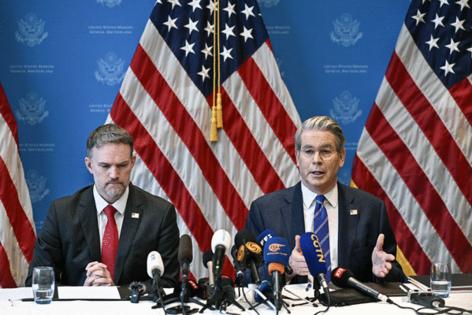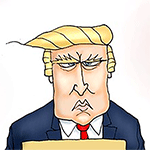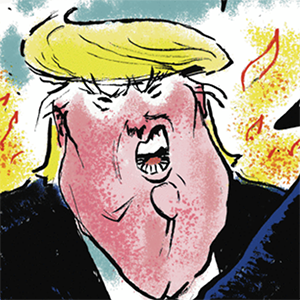US, China to slash tariffs during 90-day reprieve for talks
Published in News & Features
The U.S. and China will temporarily lower tariffs on each other’s products in a dramatic ratcheting down of trade tensions that buys the world’s two largest economies three months to work toward a broader agreement.
The combined 145% U.S. levies on most Chinese imports will be reduced to 30% including the rate tied to fentanyl by May 14, while the 125% Chinese duties on U.S. goods will drop to 10%, according to a joint statement and from officials in a briefing Monday in Geneva.
“We are in agreement that neither side wants to decouple,” Treasury Secretary Scott Bessent said, adding that “we had a very robust and productive discussion on steps forward on fentanyl” and that talks might lead to China buying more American-made products.
“We would like to see China open to more U.S. goods,” Bessent said. “We expect that as the negotiations proceed, that there will also be the possibility of purchase agreements to pull what is our largest bilateral trade deficit into balance.”
Bessent added that the tariff reductions don’t apply to sectoral duties imposed on all U.S. trading partners, and the tariffs applied on China during the first Trump administration remain in place. Asked what would happen at the end of 90 days to avoid tariffs ratcheting back up, Bessent indicated there’s a chance to extend the truce further.
“Just like with all our other trading partners, as long as there is good faith effort, engagement and constructive dialog, then we will keep moving forward,” he said.
Equity markets in Asia and Europe rose, and S&P 500 futures jumped 3%. Oil prices increased, Treasury yields gained and the dollar was stronger. The offshore yuan strengthened, rising by more than 0.5% before paring gains. China’s bonds fell, with the 30-year yield climbing by six basis points, the most since March, to 1.95%.
The U.S. statement also said “the parties will establish a mechanism to continue discussions about economic and trade relations.”
In a research note, Maeva Cousin of Bloomberg Economics said today’s move “substantially lowers the U.S. average tariff shock on China,” though the remaining import taxes remain high and could still cut U.S. imports from China by about 70% in the medium term.
Beijing’s response
China also said it would suspend or cancel its non-tariff countermeasures imposed on the U.S. since April 2. That’s an apparent reference to China’s addition on April 4 of seven rare earths to its export control list. Securing the removal of those restrictions was a priority for Washington as a range of industries faced disruption.
China has always handled relations with the U.S. based on the principles of mutual respect, the official Xinhua News Agency reported, citing a white paper on national security. China is committed to the stable development of relations with the U.S., it said, and imposing pressure and threats are not the right way to deal with China.
“The agreement, which significantly lowers tariffs without any concessions, is likely to be viewed as a particular victory for China,” Lynn Song, ING’s chief economist for greater China, wrote in a research note.
Around the same time the tariff reductions were unveiled, China released a white paper on national security that vowed to add more tools to Beijing’s retaliation toolkit and improve mechanisms for countering sanctions and so-called long-arm jurisdiction.
The de-escalation comes after recent data showed a slump in trade across the Pacific Ocean. The two countries had earlier reported “substantial progress” in talks, which buoyed markets and helped Chinese stocks recoup their losses since President Donald Trump’s “Liberation Day” announcement of tariffs on April 2.
Ryan Petersen, the founder and CEO of digital logistics platform Flexport Inc., posted a note on X indicating he expects a race to transport goods across the Pacific given the tariff reprieve. “Get ready for a shipping boom,” he wrote without elaborating.
‘Came to deal’
Trade Representative Jamieson Greer said the U.S. wants to have more balanced trade with China and “our Chinese counterparts clearly came to deal this week.”
Before the talks began in Switzerland, Trump has posted on Truth Social that an 80% tariff on China “seems right,” but left it up to his Treasury chief to decide.
Asked on Monday how the U.S. team ultimately landed on a much lower number in the talks, Greer said: “Everything is a negotiation.”
The U.S. president offers “direction and advice on how to proceed, and we ended up at a result that is very good for the United States — very good for China as well,” Greer told reporters.
He listed measures that were left in place as part of the truce, including the 10% global baseline tariff that was applied to all U.S. trading partners, as well as China-specific tariffs Trump imposed during his first term that “have been effective in reducing the U.S. bilateral trade deficit with China.”
“That leaves us in a very good position, all in, with respect to measures on Chinese imports,” Greer said. “But more importantly, leaves us on a constructive path forward to have a positive conversation with the Chinese on how to rebalance.”
Phase one
While markets have cheered recent reports of progress, history suggests that it could take a long time to reach a detailed agreement, if one is possible at all. In 2018, the two sides also agreed to put their dispute “on hold” after a round of negotiations, but the U.S. soon backed away from that deal, leading to more than 18 months of further tariffs and talks before the signing of the “Phase One” trade deal in January 2020.
In the end, China failed to live up to the purchase agreement in that deal and the U.S. trade deficit with China jumped during the pandemic, setting up the current trade war.
Greer made clear that discussions about the phase one deal did not factor into this weekend and it remains unclear if the Trump team will revisit that agreement or enforce it.
“The talks were very much focused on how do we get the tariff levels to something that is not an embargo, but still allows the United States to pursue its goal of trade deficit reduction,” he said.
For the next three months, the two sides could seek to make progress on the U.S.’s 20% fentanyl tariffs, which Trump imposed on China early in his second term.
At one point in the weekend talks, Bessent made his point by reaching into the small bowl of sugar in front of him, putting a small amount in the palm of his hand and telling his Chinese counterparts, “This would kill everyone in this room,” according to a person familiar with the episode.
He then proceeded to take out a bit more sugar and said: “This would kill everyone in Geneva,” and more to signal an amount that would kill everyone in Switzerland — shocking Chinese negotiators with his frankness, the person added.
Xu Datong, China’s vice minister of public security, was among those in the room, the person said.
-----------
—With assistance from James Mayger, Jason Rogers, Jing Li and Alan Wong.
©2025 Bloomberg L.P. Visit bloomberg.com. Distributed by Tribune Content Agency, LLC.







Comments